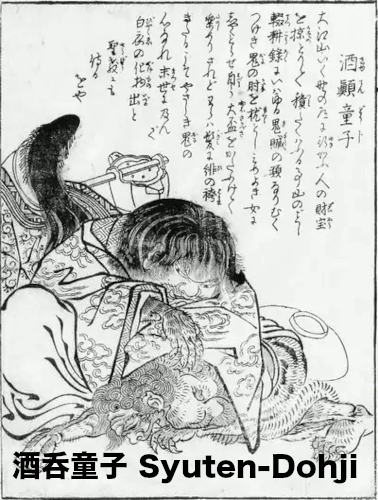Shutendohji, during the Heian period, was a oni who made his lair on Mount Ohe, along with various henchmen such as Ibakidohji. He is likely a well-known figure, as few people would be unfamiliar with him. Among his notorious traits, he was said to have a preference for women as his primary food source, enjoying their flesh and drinking their blood, which is particularly gruesome.
This time, I have researched this fearsome oni. In Japanese.
The Subjugation of Shutendohji
Shutendohji and his followers made their lair on Mount Ohe in Kyoto, where they would abduct and consume people, particularly women. Their heinous actions angered the imperial court, leading to an order for their subjugation.

The samurai who received the order for subjugation were led by Minamoto no Yorimitsu and his four loyal retainers, known as the Shitennoh. Disguised as mountain ascetics, the five of them requested to stay overnight at Shutendohji’s lair. However, Shutendohji, aware that a subjugation party had been formed, remained cautious and interrogated them with various questions.
Shutendohji is known for his love of sake
When the mountain ascetics offered Shutendohji some sake, he drank it, which caused him to loosen up and start sharing personal stories. He even provided them with the blood and flesh of the women he had abducted. Because they had dined and drunk together, Shutendohji completely let his guard down.
At that point, the samurai presented him with the “Shin-pen-kitoku-syu Sake” granted by Hachiman Daibosatsu. This poisoned sake rendered Shutendohji unable to move.
Taking advantage of his incapacitation, Yorimitsu and his retainers donned the weapons they had hidden in their carrying packs and, together as disguised warriors, subdued Shutendohji and beheaded him. The katana used in this act still exists today and is preserved as a national treasure at the National Museum under the name “Dohjigiri.”
It is said that even after his head was severed, Shutendohji bit down on Yorimitsu’s helmet, showcasing his ferocity. Since Minamoto no Yorimitsu and his four loyal retainers were historical figures, it implies that Shutendohji might have been a real person as well. Perhaps he was not an oni in the supernatural sense, but rather a bandit leader. However, once labeled a demon by influential nobles, even a human could be perceived as an oni.
In Stories, Shutendohji
Shutendohji appears in other tales as well. In the Ise Monogatari, there are depictions of him devouring women in a single bite, highlighting his terrifying nature as he would abduct women from the city of Kyoto to serve as his constant food source.
According to legend, even after being beheaded, he did not lose his vitality and declared, “I can heal ailments and injuries related to the head.” For this reason, his buried head is revered as possessing special power, leading to its enshrinement as Kubiduka Daimyohjin.
The Origin of Shutendohji
Shutendohji’s origins are said to be from Kyoto to Niigata, and a noteworthy aspect is that he was born not as an oni but as a human child from the beginning.
He was described as a handsome young man who received many love letters from women. However, he neglected their feelings and stored the letters away in a box. Later, when he opened the box, the emotions contained in the letters turned to smoke, enveloping him and transforming him into an oni. This is one of the theories surrounding his transformation.
Another characteristic is that he supposedly stayed in his mother’s womb for an unusually long time. Sometimes said to be as long as three years. There are even tales of him being born with teeth and hair. At that time, a baby with teeth was referred to as “onikko” (demon child), which is particularly interesting.
The idea of transforming from a human’s emotions into a demon may resonate with the story of Rokujo no Miyasudokoro from Genji Monogatari.
From a modern perspective, there are theories related to smallpox or the German scholar Stein Dott’s theory, but since I want to focus on him as a yokai in this context, I will refrain from discussing those.
Summery
Shutendohji’s uniqueness lies in the fact that he was not born an oni but became one after being born as a human. There are onies associated with unseen natural phenomena and spiritual occurrences, but Shutendohji is undoubtedly one of the visible demons.
Moreover, the existence of the national treasure sword “Dohjigiri” in the National Museum suggests that there was indeed a formidable entity present.
On the other hand, even after being beheaded, he displayed a terrifying vitality by biting down on Minamoto no Yorimitsu’s helmet. Legend has it that on the way back to Kyoto with his head, he repented and proclaimed that he could heal ailments and injuries related to the head. This may have led to his enshrinement as Kubiduka Daimyohjin.
Whether seen as evil or good, it seems that powerful entities tend to become objects of veneration.


コメント